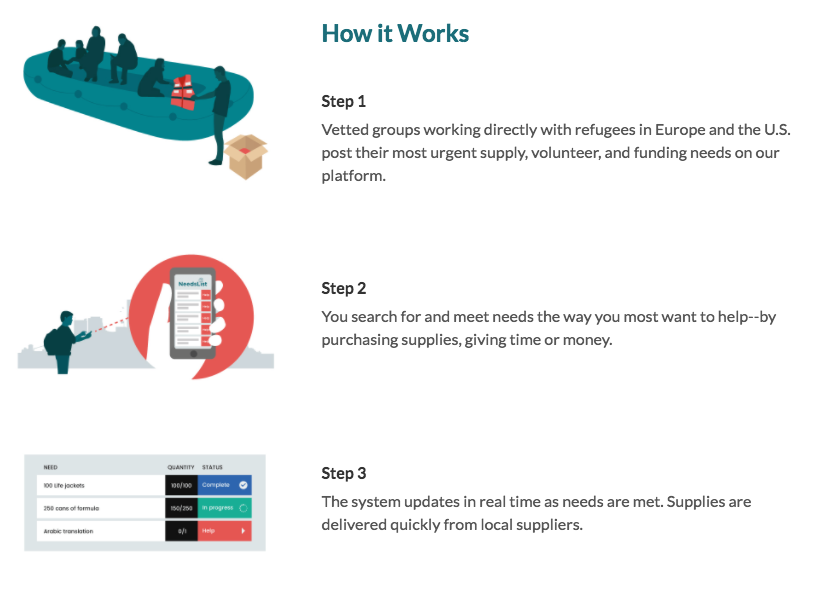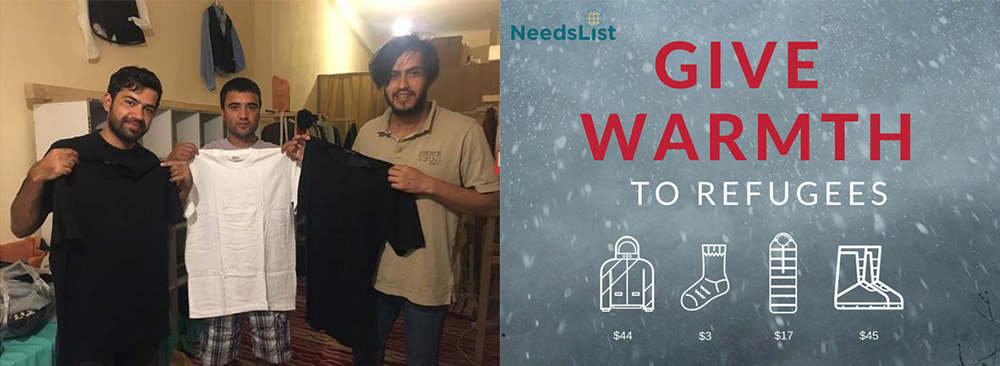NeedsList is a global marketplace connecting individual and corporate donors with NGOs to create efficiency and transparency in their humanitarian aid system. Vetted, local charities in Europe, the United States, and Puerto Rico create web-based lists of items and services they need to serve refugees and people displaced by natural disasters. Individuals and companies can purchase supplies or sponsor lists of needs from local businesses through the platform. The process reduces shipping costs and time, getting help to people who they need it, fast.
Below is our interview with Natasha Freidus, the Founder of NeedsList:

Q: What is NeedsList and how does it work?
A: When humanitarian emergencies like the Syrian refugee crisis or Hurricane Maria occur, people want to help but they don’t know how. In the autumn of 2015, we were seeing people wanting tangible ways to donate, but not knowing which groups were doing effective work. And, because those people lacked alternatives, donors were shipping goods from overseas – that’s expensive, environmentally unsustainable and often means that by the time containers arrive the items are no longer needed. That’s where the idea of NeedsList came from – this way aid is “needs-driven”, allowing donors to give in tangible ways while supporting local economies.
To date, NeedsList has met over 27,000 needs and have been recognized with multiple international awards including first place in the Ben Franklin Fintech Accelerator and recently completed the Katapult Accelerator.
 Recommended: Partner Rx: Simplifying The Business Development Process & Driving Results In M&A For Life Science Companies
Recommended: Partner Rx: Simplifying The Business Development Process & Driving Results In M&A For Life Science Companies
Q: What is the biggest challenge you’ve faced in launching NeedsList and how did you overcome it?
A: We are bringing a private sector, startup approach to a system dominated by large NGOs who struggle to keep up with the rapidly increasing pace of demand. This kind of disruption comes with its own set of challenges. We are learning that despite the real growth in numbers of social entrepreneurs, the for-profit/nonprofit binary is still a powerful mindset for both nonprofits and investors alike. Investors often question our ability to be profitable or suggest that the challenges we face are for nonprofits to solve. And even some nonprofits have questioned our ethics or declined to work with us, citing our desire to be profitable as an anathema to their values. Through it all, we stand by our belief that purpose and profit are not diametrically opposed – rather, we believe that the larger we grow, the greater impact we can have.
Q: What are the problems in the current model of humanitarian aid.
A: Today 65m people are displaced around the world. By the year 2050, the number of people displaced by conflict and natural disasters is expected to quadruple. Migration is the challenge of our generation, closely connected with conflict, poverty eradication, and global warming. Humanitarian aid is the first line of response to meet the urgent needs of displaced peoples. Yet, our current institutions can’t keep up with the rapidly increasing demand. Our largest aid organizations are facing big funding shortages — last year the UNHCR only met 50 percent of its funding goals, leaving it with a $7 billion funding gap. Despite growing acknowledgment that grassroots groups are doing some of the most impactful relief work on the ground, only .2 per cent of humanitarian aid is directed towards local efforts. We have an aid system desperately in need of aid.
Q: What’s the vision that guides you?
A: Over the past few years, I have learned directly from the inspiring NGOs working with refugees on the ground. Our partners reflect innovative strategies that highlight the need for human dignity. I believe that applying the kind of sharing economy tools we use for finding hotels or purchasing gifts can, in fact, break down our existing unilateral model of aid. Last year, when we were just getting started, the friend of a friend who was in Aleppo offered to design our logo. Too often we think of refugees as the beneficiaries of aid, and humanitarian aid workers as the providers. Yet, in a city under siege, a country at war, a trained graphic designer was the donor, and the founder of a tech startup was the one in need. There are times when we have something to give. And there are times when we are in need. And I’m learning that most of the time, both are true. For all of us. Our vision for NeedsList is to create a way that we can support and embrace one another in times of need.
 Recommended: Scott & Scott: Boutique Intellectual Property And Technology Law Firm Located In The Dallas-Fort Worth Area
Recommended: Scott & Scott: Boutique Intellectual Property And Technology Law Firm Located In The Dallas-Fort Worth Area
Q: What are your plans for the future?
A: We are just now launching NeedsList in Puerto Rico to support hurricane relief work and will be testing a chatbot to make it easier for aid workers to identify and upload needs from the field. We will continue to grow the platform, both in terms of geography but also as we test out new technologies that can make sure we are growing efficiently and effectively.
We also know that in order to meet demand at scale we can’t rely on individual donors and thus are building out an enterprise version of the platform for companies that want their employees to engage in meaningful giving.
Activate Social Media:


